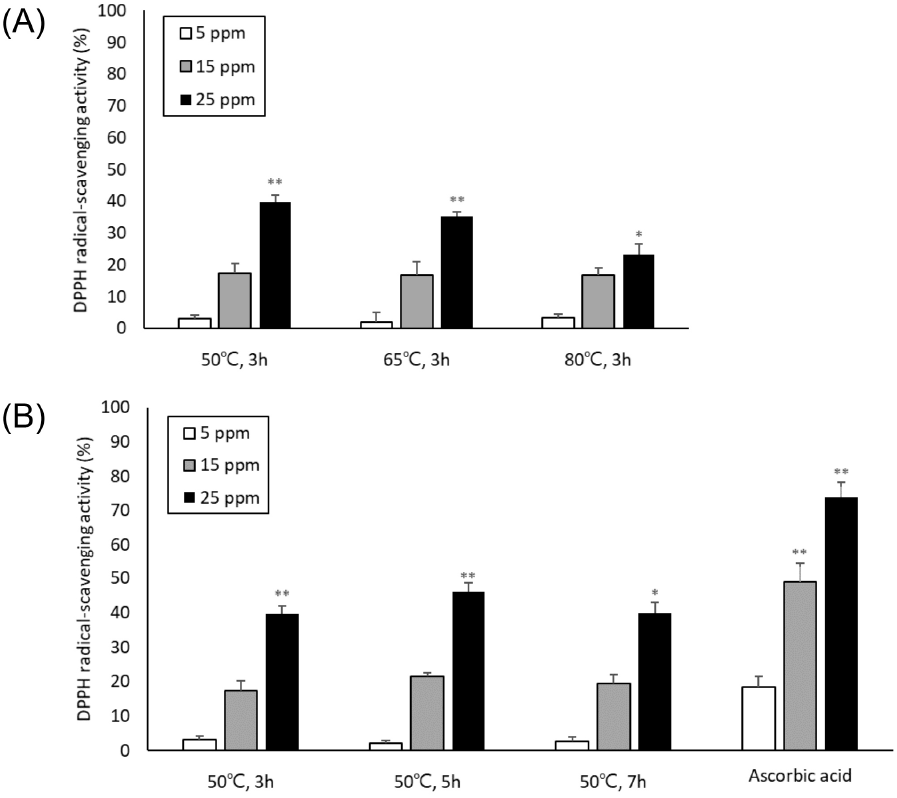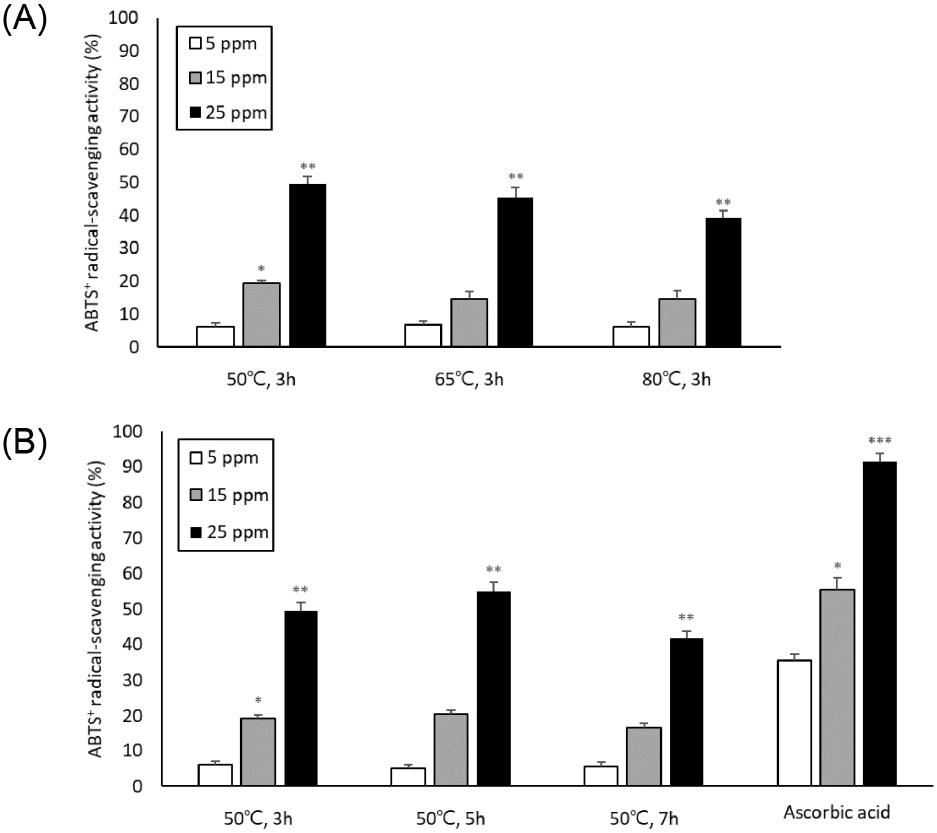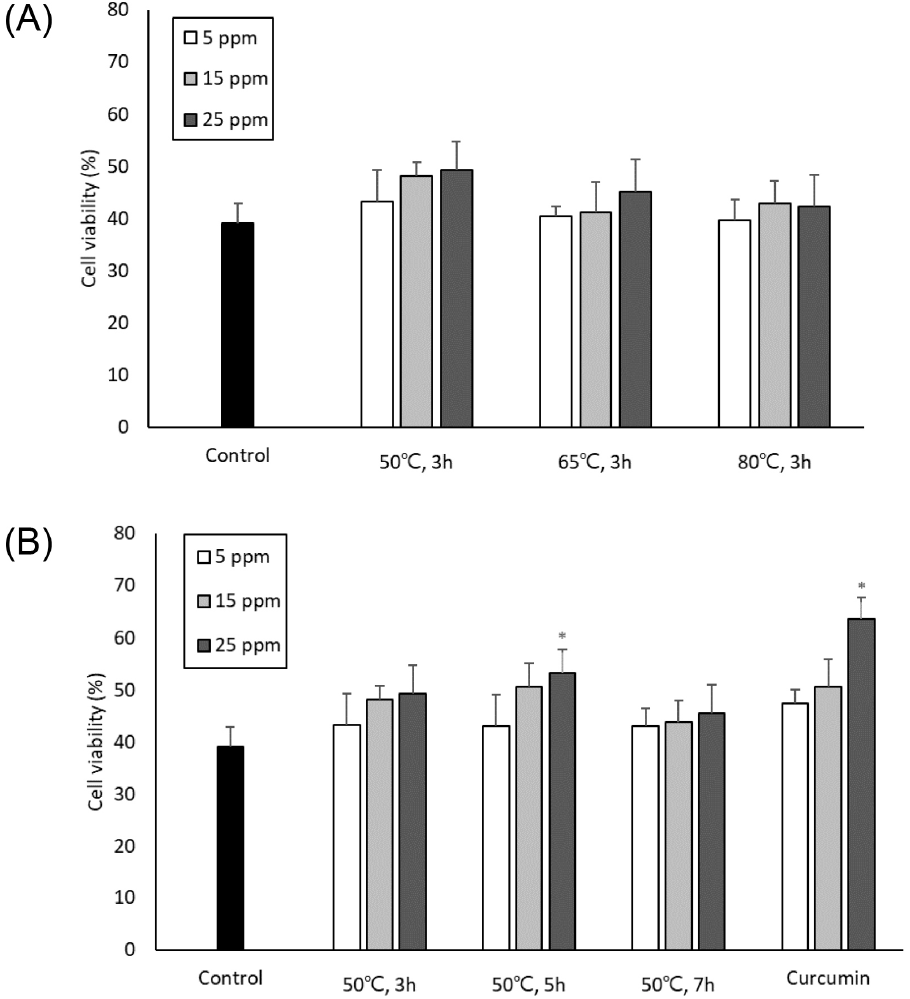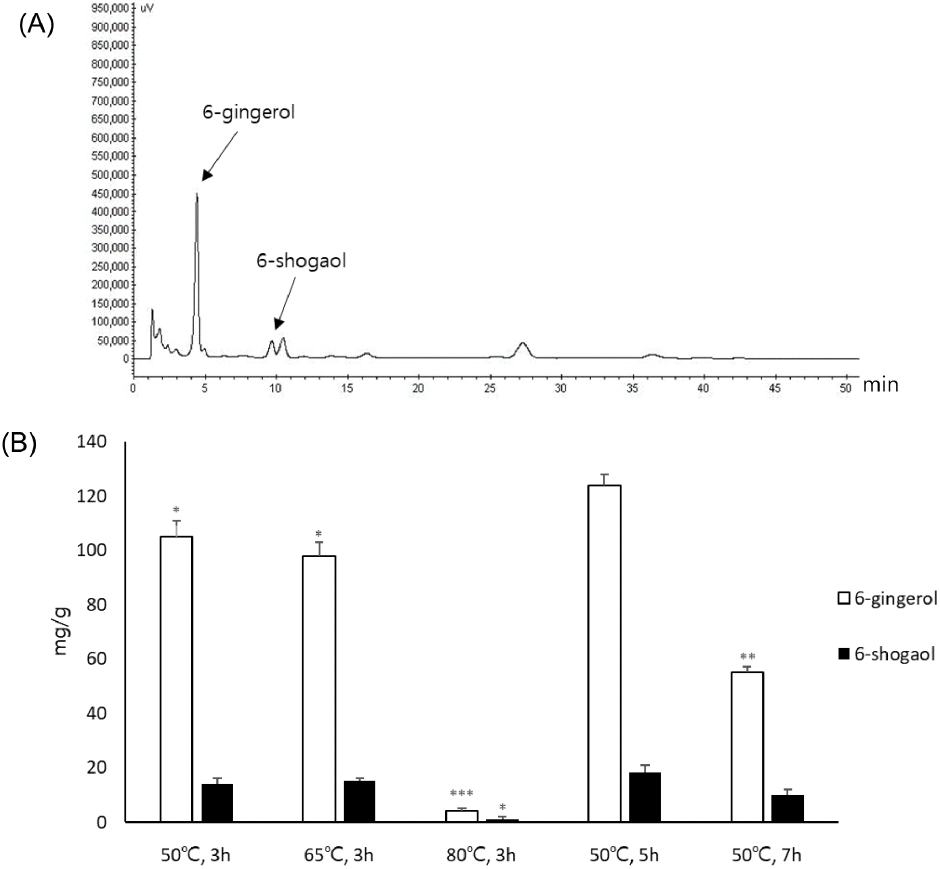Article
추출조건에 따른 생강 추출물의 항산화 활성 및 산화스트레스에 의한 근육세포 보호 효과
최상윤1,*
,
김경탁1
Anti-oxidative and muscle cell protective effects of ginger extract according to the extraction conditions
Sang Yoon Choi1,*
,
Kyung-Tack Kim1
Author Information & Copyright ▼
1Korea Food Research Institute, Wanju 55365, Korea
*Corresponding author Sang Yoon Choi, Tel: +82-63-219-9307, E-mail:
sychoi@kfri.re.kr
Citation: Choi SY, Kim KT. Anti-oxidative and muscle cell protective effects of ginger extracts according to the extraction conditions. Korean J Food Preserv, 29(5), 762-767 (2022)
Copyright © The Korean Society of Food Preservation. This is an Open-Access article distributed under the terms of the
Creative Commons Attribution Non-Commercial License (http://creativecommons.org/licenses/by-nc/4.0/) which permits
unrestricted non-commercial use, distribution, and reproduction in any
medium, provided the original work is properly cited.
Received: Jun 20, 2022; Revised: Aug 08, 2022; Accepted: Aug 09, 2022
Published Online: Aug 31, 2022
4. 요약
생강의 항산화 효과는 널리 알려져 있으며, Seo(2017)와 Lee 등(2011)은 생강을 유산균으로 발효하거나 45°C 이상에서 초임계 추출함으로써 항산화 활성을 높일 수 있다고 보고한 바 있다. 그러나 발효나 초임계 등의 추가공정 없이 보다 경제적이고 효율적으로 추출하는 조건 및 방법에 대한 연구는 상대적으로 미비한 실정이다. 본 연구는 저장성을 높여 산업적용성과 경제성을 높이기 위해 생강을 건조 후, 식용 가능한 에탄올을 사용하여 여러 가지 조건으로 추출하고 항산화 효과와 활성성분 함량을 비교하여 항산화 효과를 높일 수 있는 최적의 추출온도와 시간을 측정하고자 하였다. 측정결과 추출온도는 50°C에서, 추출시간은 5시간 동안 추출한 생강 추출물이 가장 높은 항산화 효과를 나타내었으며, 활성성분인 6-gingerol과 6-shogaol 함량 역시 높게 나타났다. 수율은 추출시간에 따른 차이는 미비하였고 온도가 높아질수록 소폭 증가하였으나 큰 차이는 없었다. 따라서 생강 에탄올 추출물을 이용한 항산화 소재 제조 시에는 50°C에서 5시간 동안 추출하는 것이 가장 적합할 것으로 사료된다.
Abstract
Ginger (Zingiber officinale Rosc.) root is known to have anti-oxidative effects. However, studies on the extraction conditions to obtain ginger extract (GE) with high antioxidant power have not yielded satisfactory results. Therefore, the effects of extraction temperature and time on the anti-oxidative effects of GE were investigated. The content of 6-gingerol and 6-shogaol in the GE was also analyzed. The results revealed that extraction carried out at 50°C for 5 h was optimal for maintaining the anti-oxidative activity of the GE. Further, GE obtained under these optimal conditions exhibited the highest DPPH and ABTS+ radical scavenging activities and cytoprotective effect against oxidative damage in L6 skeletal muscle cells and was rich in active compounds. Thus, the GE obtained under the optimal conditions could be useful for the development of functional food materials.
Keywords: ginger; extraction; antioxidant; gingerol; shogaol
1. 서론
생강(Zingiber officinale Rosc.)은 생강과에 속하는 여러해살이풀로서, 뿌리는 독특한 향과 맛을 가지고 있어 전 세계적으로 향신료로서 널리 사용되고 있다. 생강의 생리활성에 대한 연구로는 항산화 효과(Ali 등, 2008; Lee 등, 2011)를 비롯하여 항염증(Kim과 Kim, 2018), 항균(Jung과 Park, 2013), 항암(de Lima 등, 2018), 항당뇨(Rani 등, 2012; Wei 등 2017), 항비만(Kim 등, 2018) 효과 등이 보고된 바 있다. 생강에 함유된 성분으로는 매운맛 정유성분인 gingerol, shogaol이 대표적이며 이밖에 zingiberol, zingiberene, γ-cardinen 등이 알려져 있다(Mao 등, 2019). 이들 중 6-gingerol과 6-shogaol은 뛰어난 항산화 효과를 나타낸다고 보고된 바 있다(Abolaji 등, 2017; Chen 등, 2014; Melissa 등, 2015; Semwal 등, 2015).
이처럼 생강과 생강성분의 생리활성에 대한 연구는 활발히 진행되었으나 이들 활성성분을 효과적으로 추출하고 이용하는 방법에 대한 연구는 상대적으로 미비한 실정이다. 따라서 본 연구에서는 장기적인 저장과 유통이 어려운 작물인 생강의(Sung, 2010) 저장성을 높여 산업적용성과 경제성을 높이기 위해, 건조한 후 추출온도 및 시간별로 식용이 가능한 에탄올을 이용 하여 추출하고 비교분석하여 생강으로부터 항산화 활성이 높은 추출물을 얻을 수 있는 최적의 추출조건을 찾고자 하였다. 또한, 이들 생강 추출물의 활성산소로부터의 근육세포 보호 효과를 측정하여 항산화 및 근력개선 용도의 기능성 식품의 개발 등에 활용 가능성을 확인하고자 하였다.
2. 재료 및 방법
2.1. 실험재료
본 연구에서 사용한 생강은 전북 봉동지역에서 생산된 것을 사용하였으며 열풍건조(50°C, 24시간) 후 마쇄한 다음, 6배의 에탄올(99.5%)을 사용하여 교반 추출하였다. 추출온도에 따른 시료는 50, 65, 80°C에서 3시간 동안 환류추출한 후 여과하고 상등액을 회전감압농축기(Buchi, Japan)로 농축하여 제조하였고, 추출시간에 따른 시료는 3, 5, 7시간 동안 추출한 후 여과하고 얻어진 상등액을 감압농축하여 −50°C에 보관하면서 실험시료로 사용하였다.
2.2. DPPH radical 소거효과 측정
에탄올(80%)에 녹인 각각의 생강 추출물 200 μL와 0.4 mM DPPH(2,2-diphenyl-1-picrylhydrazyl, Sigma-Aldrich Inc, St. Louis, MO, USA) 용액 800 μL를 가한 후 혼합하였다. 20분간 암소에서 반응시킨 후 517 nm에서 흡광도를 측정하였고 활성대조군은 ascorbic acid(Sigma-Aldrich, MO, USA)를 사용하였다.
2.3. ABTS + radical 소거효과 측정
Phosphate buffered saline(PBS, 0.1 M, pH 7.4)에 2.5 mM 2,2’-azino-bis(3-ethylbenzothiazoline-6-sufonic acid)(ABTS, Wako, Japan)와 1 mM 2,2’-azobis(2-methylpropionamidine) dihydrocholide(AAPH, Wako, Japan)를 혼합하여 68°C의 암실에서 12분간 반응시킨 후 냉각시켰다. 냉각된 용액 980 μL에 PBS에 녹인 각각의 농도의 생강 추출물 20 μL를 가하여 37°C에서 10분간 반응시킨 후, 734 nm에서 흡광도를 측정하였다. 활성대조군은 trolox(Sigma-Aldrich, MO, USA)를 사용하였다.
2.4. 세포 배양 및 분화
Rat의 근육 유래 L6 cell line은 한국세포주은행에서 분양받아 사용하였으며 10% fetal bovine serum(FBS, Gibco, USA), 1% antibiotic antibiotics(AA, Gibco, USA)를 포함한 Dubecco’s modified Eagle’s medium (DMEM, Gibco, USA)을 사용하여 37°C, 5% CO2 조건에서 배양하였다. 배양된 세포는 2% horse serum(Gibco, USA)과 1% AA를 포함한 DMEM을 사용하여 myotube로 분화시킨 후 실험을 수행하였다.
2.5. 근육세포 보호 효과 측정
근육세포의 산화적 손상에 대한 생강시료의 보호 효과를 알아보기 위하여 L6 세포에 각각의 농도의 생강 추출물과 1.5 mM H2O2를 동시에 처리하고, 다시 24시간 동안 배양시킨 후 MTT(0.5 mg/mL in PBS) 용액으로 염색하여 540 nm에서의 흡광도를 측정하였다. 생강 추출물의 L6 세포 보호 효과는 과산화수소 처리 시의 세포사멸률에 대한 생강 추출물 처리 시의 회복률을 산출하여 백분율(%)로 나타내었다.
2.6. 유용성분 함량 분석
생강 추출물에 함유된 6-gingerol과 6-shogaol의 함량은 HPLC(Jasco, Tokyo, Japan)를 이용하여 분석하였다. 컬럼은 Waters symmetry C8(150×3.9 mm)을 사용하였으며, 이동상 용매는 MeOH/H2O=65/35(v/v) 혼합용매를 사용하여 1 mL/min의 유속으로 용출하여 282 nm에서 검출하였다. 분석시료는 각각의 생강 추출물을 메탄올에 녹인 후 0.45 μm 필터로 여과하여 사용하였다.
2.7. 통계분석
각 실험결과는 평균±표준편차로 표시하였으며 GraphPad Prism 6.0(GraphPad Software, San Diego, CA, USA) 프로그램을 이용하여 one-way ANOVA, Tukey’s post hoc test로 분석하였고, 유의수준은 p<0.05 수준으로 설정하였다.
3. 결과 및 고찰
3.1. 추출조건에 따른 라디컬 소거효과 변화
추출온도에 따른 생강추출물의 항산화 효과를 비교하기 위해 생강을 50, 65, 80°C에서 3시간 동안 추출하여 DPPH 및 ABTS+ 라디컬 소거효과를 측정하였다. 측정결과 Fig. 1, 2와 같이 50°C에서 추출한 생강 추출물이 25 ppm에서 39.7%의 DPPH 소거효과와 49.6%의 ABTS+ 소거효과를 나타내어, 65, 80°C 추출시료에 비하여 가장 높은 항산화 효과를 나타내었다. 또한, 가장 우수한 활성을 나타낸 50°C로 추출시간을 3시간, 5시간, 7시간으로 하여 추출물을 제조하고 DPPH와 ABTS+ 라디컬 소거효과를 측정한 결과, 5시간 추출한 생강추출물이 25 ppm에서 가장 우수한 DPPH 소거활성(46.2%)과 ABTS+ 소거활성(55.1%)을 나타내었다. Lee 등(2011)은 생강을 70% 에탄올로 24시간씩 3회 추출한 후 여러 용매분획을 하여 DPPH와 ABTS+ 라디컬 소거효과를 비교한 결과 EtOAc 분획에서 에탄올 추출물보다 높은 DPPH 소거효과를, n-hexane 분획에서 에탄올 추출물보다 높은 ABTS+ 소거효과를 나타낸다고 보고한 바 있어, 향후 비극성 용매를 이용한 생강 추출조건에 대한 연구도 최적의 항산화 추출물 제조를 위하여 필요할 것으로 사료된다.
Fig. 1.
DPPH radical scavenging activities of ginger extracts.
(A) Scavenging activity according to extraction temperature for 3 h, (B) Scavenging activity according to extraction time at 50°C. Ascorbic acid used as positive control. Data represent the mean±SD (n=3). *p<0.05, **p<0.01 compared with non-treated group.
Download Original Figure
Fig. 2.
ABTS+ radical scavenging activities of ginger extracts.
(A) Scavenging activity according to extraction temperature for 3 h, (B) Scavenging activity according to extraction time at 50°C. Ascorbic acid used as positive control. Data represent the mean±SD (n=3). *p<0.05, **p<0.01, ***p<0.001 compared with non-treated group.
Download Original Figure
3.2. 산화적 손상으로부터 근육세포 보호 효과
생강 추출물을 25 ppm 농도로 L6 세포에 처리하여 세포사멸을 일으키지 않는 것을 확인한 후 1.5 mM의 과산화수소와 각각의 농도의 생강추출물을 동시에 처리하여 과산화수소에 의한 세포사멸을 억제하는지 측정하였다(Fig. 3). L6 세포에 1.5 mM 과산화수소만을 처리 시 60.9%의 세포가 사멸되었고, 생강시료를 동시에 처리한 결과 50°C에서 3시간 추출한 생강추출물이 25 ppm 처리농도에서 세포사멸률이 50.8%로 감소되어 10.1%의 세포보호 효과를 나타내었고, 이는 65, 80°C 추출시료에 비하여 높은 경향을 나타내었다. 추출시간별로는 50°C에서 5시간 동안 추출한 생강 추출물이 25 ppm 농도에서 과산화수소 처리군 대비 14.1%의 유의적인 세포보호 효과를 나타내었고, 이는 앞서의 DPPH와 ABTS+ 라디컬 소거효과 측정결과와 일치하는 경향을 나타내었다. 따라서 생강 에탄올 추출 시에는 50°C에서 5시간 동안 추출하는 것이 우수한 항산화 효과를 기대할 수 있을 것으로 판단된다.
Fig. 3.
Protective effects of ginger extracts against H2O2-induced oxidative damage in L6 muscle cells.
(A) Protective effect according to extraction temperature for 3 h, (B) Protective effect according to extraction time at 50°C. Control, H2O2-treated group. Curcumin used as positive control. Data represent the mean±SD (n=3). *p<0.05, significantly different from the control group.
Download Original Figure
3.3. 추출수율 및 활성성분 함량
각각의 생강 추출물의 추출수율은 Table 1과 같다. 온도에 따라서는 온도가 높을수록 추출수율도 증가하여 80°C에서 추출된 생강추출물이 가장 높은 추출수율을 나타내었으나 주요활성성분인 6-gingerol과 6-shogaol 함량은 50°C에서 추출된 생강추출물에 비하여 크게 감소하였으며(Fig. 4), 이는 높은 열로 인해 6-gingerol과 6-shogaol이 변성된 것으로 추측된다. 이러한 결과는 Ko 등(2019)의 생강 80°C 아임계수 추출물이 60°C 아임계수 추출물에 비하여 6-gingerol과 6-shogaol 함량이 감소하는 경향과 일치하였다. 추출시간에 따른 추출수율은 큰 변화가 없었으며 이 중 5시간 추출물의 6-shogaol 및 6-gingerol 함량이 3시간이나 7시간 추출물보다 높았다. Lee 등(2011)의 보고에 따르면 생강을 분획물의 항산화 효과를 측정한 결과, 6-gingerol과 6-shogaol 함량이 높은 추출물의 항산화 효과가 높은 경향을 나타내었고 Dugasani(2010) 등과 Semwal(2015)은 gingerol과 shogaol의 항산화 효과를 보고한 바 있다. 본 연구결과에서도 6-gingerol과 6-shogaol 함량과 생강 추출물의 항산화 효과는 전체적으로 일치하는 경향을 나타내어, 이들 성분이 생강의 항산화 효과에 크게 기여함을 확인할 수 있었다.
Fig. 4.
Quantitative analysis of 6-gingerol and 6-shogaol in ginger extracts.
(A), HPLC chromatograms of ginger extract (50°C, 5 h), (B) Concentrations of 6-gingerol and 6-shogaol in ginger extracts. Data represent the mean±SE. *p<0.05, **p<0.01, ***p<0.001 compared with ginger extract (50°C, 5 h).
Download Original Figure
Table 1.
Extraction yields of ginger extracts
Data are present the mean±SE of two experiments. *p⟨0.05, significantly different from the ginger extract (50°C, 5 h) group.
| Ginger extracts |
Yields (%) |
| 50°C, 3 h |
10.8±0.3 |
| 65°C, 3 h |
12.1±0.6 |
| 80°C, 3 h |
12.6±0.3* |
| 50°C, 5 h |
10.7±0.3 |
| 50°C, 7 h |
10.4±0.2 |
Download Excel Table
감사의 글
본 연구는 한국식품연구원 기본연구개발사업(E0210300)과 농림기술개발사업의 지원에 의해 이루어졌으며 이에 감사드립니다.
References
Abolaji AO, Ojo M, Afolabi TT, Arowoogun MD, Nwawolor D, Farombi EO. Protective properties of 6-gingerol-rich fraction from
Zingiber ocinale (ginger) on chlorpyrifos-induced oxidative damage and inflammation in the brain, ovary and uterus of rats. Chem Biol Interact, 270, 15-23 (2017)



Ali BH, Blunden G, Tanira MO, Nemmar A. Some phytochemical, pharmacological and toxicological properties of ginger (
Zingiber officinale Roscoe): A review of recent research. Food Chem Toxicol, 46, 409-420 (2008)



Chen H, Fu J, Chen H, Hu Y, Soroka DN, Prigge JR, Schmidt EE, Yan F, Major MB, Chen X, Sang S. Ginger compound [6]-shogaol and its cysteine-conjugated metabolite (M2) activate Nrf2 in colon epithelial cells
in vitro and
in vivo. Chem Res Toxicol, 27, 1575-1585 (2014)




de Lima RMT, Dos Reis AC, de Menezes APM, Santos JVO, Filho JWGO, Ferreira JRO, de Alencar MVOB, da Mata AMOF, Khan IN, Islam A, Uddin SJ, Ali ES, Islam MT, Tripathi S, Mishra SK, Mubarak MS, Melo-Cavalcante AAC. Protective and therapeutic potential of ginger (
Zingiber officinale) extract and [6]-gingerol in cancer: A comprehensive review. Phytother Res, 32, 1885-1907 (2018)



Jung K, Park CS. Antioxidative and antimicrobial activities of juice from garlic, ginger, and onion. Korean J Food Preserv, 20, 134-139 (2013)


Kim S, Lee MS, Jung S, Son HY, Park S, Kang B, Kim SY, Kim IH, Kim CT, Kim Y. Ginger extract ameliorates obesity and inflammation via regulating MicroRNA-21/132 expression and AMPK activation in white adipose tissue. Nutrients, 10, 1567 (2018)




Ko MJ, Nam HH, Chung MS. Optimization of drying conditions for the conversion of 6-gingerol to 6-shogaol under subcritical water extraction from ginger. Korean J Food Sci Technol, 51, 447-451 (2019)

Lee EJ, Yang SA, Choi HD, Im HG, Whang K, Lee IS. Comparison of gingerols in various fractions and the antioxidant effects of supercritical fluid extracts from ginger. Korean J Food Sci Technol, 43, 469-474 (2011)


Rani MP, Krishna MS, Padmakumari KP, Raghu KG, Sundaresan A.
Zingiber officinale extract exhibits antidiabetic potential via modulating glucose uptake, protein glycation and inhibiting adipocyte differentiation: An
in vitro study. J Sci Food Agric, 92, 1948-1955 (2012)



Seo YH. Antioxidant and antimicrobial activities of ginger with aging and fermentation. Korean J Food Preserv, 24, 1180-1187 (2017)


Sung KC. A study on the pharmaceutical characteristics and analysis of natural ginger extract. J Korean Appl Sci Technol, 27, 266-272 (2010)

Wei C, Tsai Y, Korinek M, Hung P, El-Shazly M, Cheng Y, Wu Y, Hsieh T, Chang F. 6-Paradol and 6-shogaol, the pungent compounds of ginger, promote glucose utilization in adipocytes and myotubes, and 6-paradol reduces blood glucose in high-fat diet-fed mice. Int J Mol Sci, 18, 168 (2017)


















